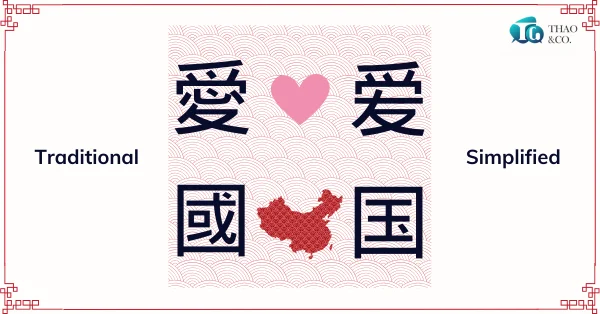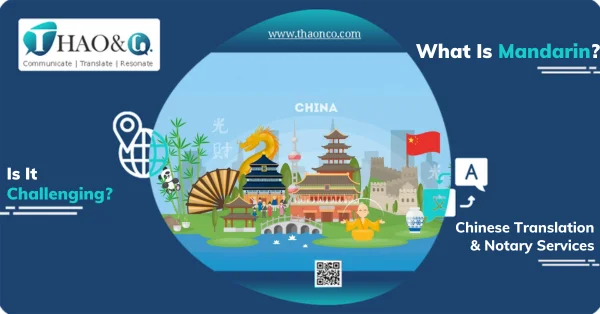What is Mandarin? It is the most widely spoken language in the world, with one-fifth of the global population using it. This makes it a top choice for anyone learning Chinese or planning to visit mainland China.
But how does Mandarin differ from other Chinese dialects? Join Thao & Co. to find the answer in this article.
Mandarin, also known as Standard Chinese or 普通话 (pŭtōnghuà), is the official language of Mainland China and Taiwan. It is also widely spoken in regions with large Chinese communities, such as Singapore, Malaysia, the United States, Canada, etc.
As China’s most dominant dialect, Mandarin is based on the Beijing dialect and follows the Pinyin system. It features 4 main tones, which play a crucial role in distinguishing meanings between words.
Mandarin serves as the standard language for communication across various fields, including education, media, and government affairs in China. It is also recognized as one of the 6 official languages of the United Nations.

Mandarin is a standardized form of spoken Chinese rooted in the Beijing dialect, a branch of the Sinitic language family. It has served as the official language of China for centuries.
Unlike English and many other phonetic languages, Chinese uses a pictorial writing system. Today, there are two main forms of written Chinese: Traditional and Simplified.
Since Mandarin is a spoken language, it isn’t classified as either. Instead, it is a standardized way of pronouncing Chinese characters, which can be written in both forms.
Simplified Chinese is used in Mainland China and Singapore, while Traditional Chinese is primarily used in Taiwan, Macau, Hong Kong, and many overseas Chinese communities.

The idea that “China speaks Chinese” isn’t as straightforward as it seems. “Chinese” actually refers to a language family, with Mandarin and Cantonese being the most widely spoken dialects. While they share a common root, they have distinct characteristics that set them apart.
Both Mandarin and Cantonese are tonal languages, meaning the pitch and inflection of a word can change its meaning. However, the number of tones differs. Mandarin has 4 tones plus a 5th neutral tone, while Cantonese has between 6 and 9 tones, depending on the classification system.
For example, the character 史 in the word “history” (历史) is pronounced shǐ with a 3rd falling-rising tone in Mandarin, whereas in Cantonese, it is pronounced si2 with a 2nd mid-rising tone.
Cantonese grammar tends to be more complex than Mandarin. While both dialects follow the Subject-Verb-Object (SVO) sentence structure, Cantonese allows for more flexibility in word order based on emphasis and meaning.
For example, the sentence “I give you a book” uses the same characters but differs in word order:
When forming negative sentences, each language also uses different negation particles. In particular:
Mandarin and Cantonese characters share the same roots in ancient Chinese. However, Mandarin now primarily uses simplified characters, while Cantonese speakers still tend to use traditional characters. As the name suggests, simplified characters have fewer strokes and are less complex than traditional ones.
Mandarin speakers typically write in Standard Written Chinese, whereas Cantonese incorporates unique characters and expressions that represent sounds and colloquialisms, many of which have no direct Mandarin equivalent.
For example, the word for “elevator” in Mandarin is 电梯, while in Cantonese, it is written as 電梯.
Mandarin serves as the official language and is widely spoken in:
Cantonese, on the other hand, is primarily spoken in southern China and among overseas Chinese communities, including:

Whether learning Mandarin is worth it depends on your personal choice and reasons for learning. Assessing your goals and interests can help determine if it aligns with what you want to achieve.
Here’s a breakdown of the benefits and challenges to help you decide:


Thao & Co. hopes the above information has shed light on the questions of What is Mandarin, and Is It Simplified or Traditional, as well as the benefits and challenges of learning the language.
Mastering this language in today’s global economy can be a big step forward in the business ladder, unlocking plenty of opportunities in China, Singapore, Hong Kong, and beyond.
However, dialectal variations, unique writing systems, and cultural nuances can pose significant challenges when translating Chinese into other languages. If not handled with expertise, these complexities can lead to miscommunication.
With years of experience in Chinese document translation, Thao & Co. proudly delivers top-tier translation services to help you overcome language barriers:
 Translation and interpretation of Mandarin and over 50 other languages.
Translation and interpretation of Mandarin and over 50 other languages. Document translation across diverse fields: legal, engineering, linguistics, healthcare, etc.
Document translation across diverse fields: legal, engineering, linguistics, healthcare, etc. Comprehensive services, including notarized translation, creative translation, subtitles, etc.
Comprehensive services, including notarized translation, creative translation, subtitles, etc.For more details, simply submit your information through our Get a Quote page or chat with us directly on our website. Our specialists will get back to assist promptly!